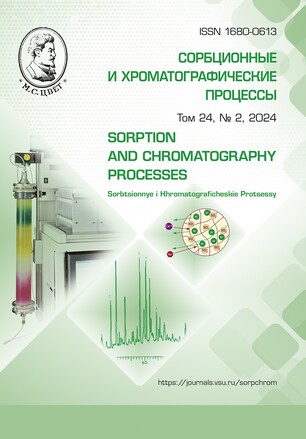Study of the stability of the biologically active compound N-[2-[4-oxo-3(4H)-quinazolinyl]propionyl]-guanidine using electrophoresis and mass spectrometry
Abstract
At the Scientific Centre of Innovative Medicines of Volgograd State Medical University, a number of pyrimidine derivatives of guanidine were designed and synthesised to study them as promising inhibitors of sodium-hydrogen exchanger isoform 1 (NHE-1), which can reduce tissue damage during ischemia. N-[2-[4-oxo-3(4H)-quinazolinyl]propionyl]-guanidine (VMA-13-15) proved to be the most pharmacologically valuable compound. When preparing regulatory documentation for a new medicine, one of the quality criteria is the amount of related impurities. They can be technological impurities and degradation products of the active substance. The aim of the research was to study the stability of the biologically active compound N-[2-[4-[4-oxo-3(4H)-quinazolinyl]propionyl]-guanidine. Anticipated degradation products were determined by stress testing, using capillary electrophoresis and mass spectroscopy. The study of the molecule of VMA-13-15 and the use of computer technologies allowed us to predict possible degradation processes. Among them, the most likely to occur is the hydrolysis reaction during thermostating of the solution of the studied compound in an alkaline medium. In silico optimisation of the geometry of the studied structures was carried out by the MM+ molecular mechanics method using HyperChem 8.0.9. The final spatial optimisation of the geometry of the modelled molecules was carried out by the density functional theory method ub3lyp with 6-311G** basis sets. The resulting vibrational analysis of thermodynamic characteristics was carried out in Orca, which allowed us to obtain enthalpy and entropy values for the studied compounds. By capillary electrophoresis, the degradation products of an aqueous solution of the studied substance were analysed by stress tests. They were used to study the effect of thermal treatment on VMA-13-15 in the presence of 0.1 M hydrochloric acid solution and 0.1 M sodium hydroxide solution. We found that the alkaline environment had the greatest effect on the stability of N-[2-[4-oxo-3(4H)-quinazolinyl]propionyl]-guanidine. It was consistent with the results of the computational experiment. We studied the mass spectrum of the degradation product detected during thermostatic treatment in alkaline medium. Based on its molar mass and release time, it was confirmed that the impurity on the chromatograms of VMA-13-15 is unsubstituted quinazolin-4(3H)-one, the initial product of the synthesis
Downloads
References
Gurova N.A., Ozerov A.A., Gurova V.V. Search and study of Na+/H+exchanger inhibitors among quinazoline derivatives containing a free guanidine group. Experimental and Clinical Pharmacology, 2018; 81(S): 66.
Linz W.J., Busch A.E. NHE-1 inhi-bition: from protection during acute is-chaemia/reperfusion to prevention/reversal of myocardial remodelling. Naunyn Schmiedebergs Arch Pharmacol, 2003; 368(4): 239-246. https://doi.org/10.1007/s00210-003-08-2
Hu Y., Lou J., Jin Z., Yang X., Shan W., Du Q., Liao Q., Xu J., Xi, R. Advances in research on the regulatory mechanism of NHE1 in tumors (Review). Oncology Let-ters, 2021; 21(4): 273. https://doi.org/10.3892/ol.2021.12534
Karmazyn M., Pierce G.N., Fliegel L. The Remaining Conundrum of the Role of the Na+/H+ Exchanger Isoform 1 (NHE1) in Cardiac Physiology and Pathol-ogy: Can It Be Rectified? Rev. Cardiovasc. Med, 2022; 23(8): 284. https://doi.org/10.31083/
j.rcm2308284.
Petrov V.I. [et al]. Patent of the Russian Federation, No. 2622638, 2017. (In Russ.)
The State Pharmacopoeia of the Russian Federation. 15th ed. Moscow: Ministry of Health of the Russian Federation; 2023. OFS.1.1.0023. Related impurities in pharmaceutical substances and medicines. (In Russ.)
The State Pharmacopoeia of the Russian Federation. 15th ed. Moscow: Ministry of Health of the Russian Federation; 2023. OFS.1.1.0009 Stability and shelf life of medicines. (In Russ.)
Teppen B.J. HyperChem, release 2: molecular modeling for the personal com-puter. J. Chem. Inf. Comput Sci, 1992; 32: 757-759.
Stephens P.J., Devlin F.J., Chaba-lowski C.F., Frisch M.J. Ab Initio Calcula-tion of Vibrational Absorption and Circular Dichroism Spectra Using Density Func-tional Force Fields. J. Phys, 1994; 98(45): 11623-11627. https://doi.org/10.1021/j100096a001.
Minkin V.I., Simkin B.Ya., Min-yaev R.M. The structure of molecules. Ros-tov N/D: Phoenix, 1997. 560 p. (In Russ.)
Neese Fr., Wennmohs Fr., Becker Ute, Riplinger Ch. The ORCA quantum chemistry program package. J. Chem. Phys, 2020; 152(22): 224108. https://doi.org/10.1063/5.0004608
Zuev A.Yu., Tsvetkov D.S. Chemi-cal thermodynamics. Yekaterinburg: Ural Publishing House. unita, 2020. 183 p. (In Russ.)
Kodonidi I.P., Chiriapkin A.S., Morozov A.V., Smirnova L.P., Ivchenko A.V., Zhilina O.M. Synthesis and thermochemi-cal modeling of reaction mechanism for producing N-acyl derivatives of 2-(2-oxo-1-pyrrolidine-1-yl) – acetamide. Izv. Vyssh. Uchebn. Zaved. Khim. Khim. Tekhnol. [Russ. J. Chem. & Chem. Tech.]. 2020; 63(2): 38-44. https://doi.org/10.6060/ivkkt.20206302.6080. (In Russ.)
Kompantseva E.V., Lutsenko D.N., Garcia E.R. Determination of biologically active compounds N-[2-[4-oxo-3(4H)-qinazolinyl]propionyl]-guanidine by capil-lary electrophoresis. Problems of biologi-cal, medical and pharmaceutical chemistry, 2020; 23(10): 40−45. https://doi.org/10.29296/25877313-2020-10-06. (In Russ.)
The State Pharmacopoeia of the Russian Federation. 15th ed. Moscow: Min-istry of Health of the Russian Federation; 2023. OFS.1.1.0026 Aspects of drug stabil-ity. (In Russ.)
Kompantseva E.V., Lutsenko D.N., Garcia E.R., Ozerov A.A., Dementieva T.M. Development of a method for deter-mining related impurities in a new biologi-cally active compound of cardioprotective action by capillary electrophoresis. Hu-mans and their health, 2023; 26(2): 73-79. https://doi.org/10.21626/vestnik/2023-2/09 (In Russ.)
Kim S., Bolton E.E. PubChem: A Large-Scale Public Chemical Database for Drug Discovery. In Daina A, Przewosny MT, Zoete V, eds. Open Access Databases and Datasets for Drug Discovery. Methods and Principles in Medicinal Chemistry, 2023; 83: 41-66. https://doi.org/10.1002/9783527830497.ch2
Palm E.H., Chirsir P., Krier J., Thiessen P.A., Zhang J., Bolton E.E., Schymanski E.L. ShinyTPs: Curating Transformation Products from Text Mining Results. Environ Sci Technol Lett, 2023; 10(10): 865-871. https://doi.org/10.26434/chemrxiv-2023-xm41h







